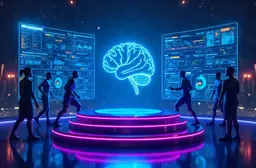How Deep Learning Changes Sports Analytics and Predictions

Table of Contents
In the era of big data processing, intelligent algorithms like neural networks can analyze advanced statistics to predict scores, optimize teams, and even anticipate opponent strategies. This approach has brought significant changes in sports analytics and predictions, enhancing efficiency, accuracy, and data-driven decision-making.
How Deep Learning Changes Sports Analytics and Predictions
The Evolution of Sports Analytics with Deep Learning
Traditional sports analytics once relied on manual observation and basic statistical records. However, the emergence of deep learning has revolutionized how we interpret sports data. Now, every athlete’s movement, game pattern, and team dynamics can be mathematically modeled using advanced predictive algorithms.
1. Transition from Manual Analysis to Automation
Manual approaches often took time and were prone to human bias. With deep learning, algorithms can process thousands of variables simultaneously, producing far more accurate real-time analysis. For example, athlete performance can now be analyzed through computer vision to detect micro-details like body positioning or sprint speed.
2. Integration of Machine Learning and Sports Data
Machine learning allows the combination of various sports data sources, such as wearable sensors, video recordings, and GPS data. By processing big data, teams can create predictive models that help with decision-making, from training strategies to player rotations.
3. NLP and Tactical Analysis
Natural Language Processing (NLP) is also used to analyze match reports, expert commentary, and even social media. This provides insights into team psychology and public sentiment, which can significantly influence match predictions.
More Accurate Match Predictions
Deep learning transforms how we predict match scores. With deep learning-based predictive algorithms, we can combine historical data, weather conditions, and current player performance to generate more accurate sports predictions.
1. Multi-Factor Predictive Models
These models integrate complex factors like player fatigue, injury history, and opponent patterns—not just simple stats. Recent research shows that deep learning models can improve score prediction accuracy by 20–30% compared to conventional methods.
2. Real-Time On-Field Analysis
Edge computing technology enables real-time analysis directly on the field. Coaches can immediately adjust strategies during a game. For example, algorithms can detect weak areas in opponents within seconds.
3. Comparing Team and Player Performance
Here’s a comparison of manual predictions vs. deep learning in sports analytics:
| Method | Prediction Accuracy | Analysis Speed | Data Complexity |
|---|---|---|---|
| Manual Analysis | 60% | Slow | Limited |
| Machine Learning | 75% | Moderate | Medium |
| Latest Deep Learning | 90% | Real-time | Highly Complex |
Optimizing Athlete and Team Performance
Beyond predictions, deep learning also plays a crucial role in optimizing athlete performance. Data-driven sports analytics allows training programs to be more effective while minimizing injury risks.
1. Physical Condition Monitoring
Through biometric sensors integrated with deep learning models, we can monitor athletes’ heart rates, sleep patterns, and fatigue levels. This data is used to design personalized and optimal training schedules.
2. Injury Prevention
Intelligent algorithms can detect early signs of injury risk. Data mining on training recordings can reveal inefficient movement patterns and alert coaches to adjust techniques.
3. Psychological and Mental Analysis
Besides physical aspects, mental state also affects performance. NLP is used to analyze interviews, team conversations, and athletes’ social media posts to understand their psychological condition.
The Future of Sports Technology
Advancements in deep learning open opportunities for more futuristic sports technologies. Sports predictions will not only become more accurate but also more personalized and interactive for fans.
1. A More Immersive Fan Experience
With real-time analytics, fans can see advanced stats and live predictions during matches. This creates new, more engaging interactions in the sports world.
2. Integration with Virtual and Augmented Reality
Soon, augmented reality will visualize athlete performance data directly in the viewing experience. Fans will see automatic highlights selected by intelligent algorithms.
3. The Era of Advanced Statistics
Using LSI and predictive analytics enables deeper statistics like the probability of successful attacks or score predictions based on game momentum.
Challenges and Ethics in Predictive Analytics
While highly beneficial, the use of deep learning in sports also brings new challenges related to privacy and ethics.
1. Athlete Data Protection
Collecting highly detailed biometric data raises privacy concerns. Strict regulations are needed to ensure data is not misused by unauthorized parties.
2. Algorithm Bias
If training data is imbalanced, algorithms can produce biased predictions. Therefore, models must be validated regularly.
3. Over-Reliance on Technology
Relying too heavily on machine learning predictions can make teams ignore human intuition. Balancing technology with coaches’ experience remains crucial.
FAQs
How does deep learning improve sports prediction accuracy? Deep learning processes complex, multi-factor data, boosting accuracy up to 90% compared to manual methods.
Is athletes’ personal data safe in this system? Security depends on regulations and encryption. Extra protection is needed to prevent data leaks.
Does this technology replace human coaches? No, it only supports coaches to make more data-driven decisions.
Can this technology be used in all sports? Yes, but its effectiveness depends on data availability and the sport type being analyzed.
Conclusion
Deep learning has revolutionized sports analytics, from match predictions and athlete performance optimization to enhancing fan experiences. With big data processing and advanced predictive algorithms, the sports world is entering a new era driven by science and technology. However, ethical and privacy challenges must still be addressed to ensure maximum benefits.
Key Takeaways
- Deep learning increases sports prediction accuracy up to 90%
- Real-time analytics help coaches adjust strategies during matches
- Injury prevention and athlete performance optimization become more effective
- Privacy and algorithm bias challenges need to be addressed
- This technology enriches fan and audience experiences
Popular Tags
ADS SPACE HERE




